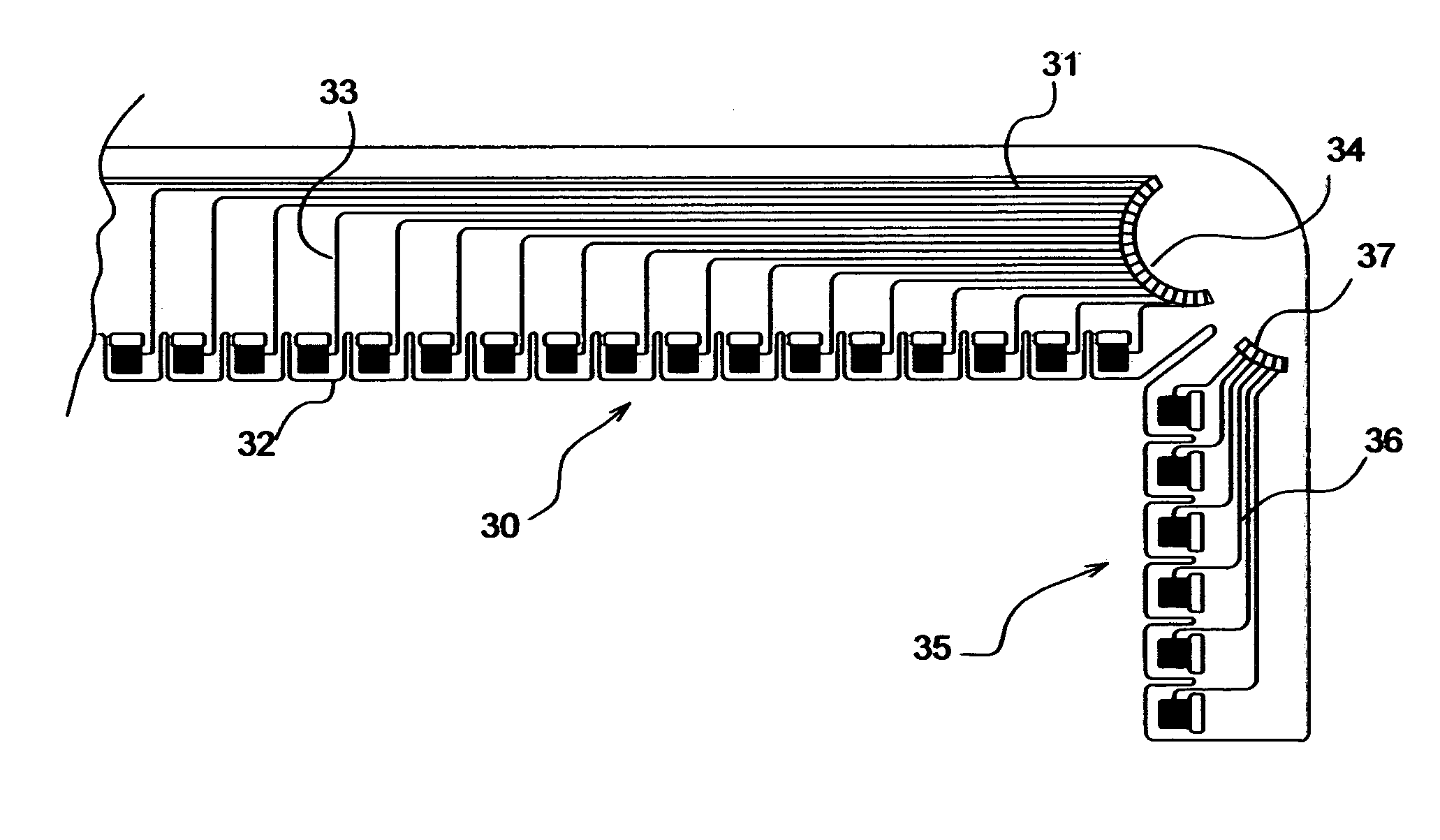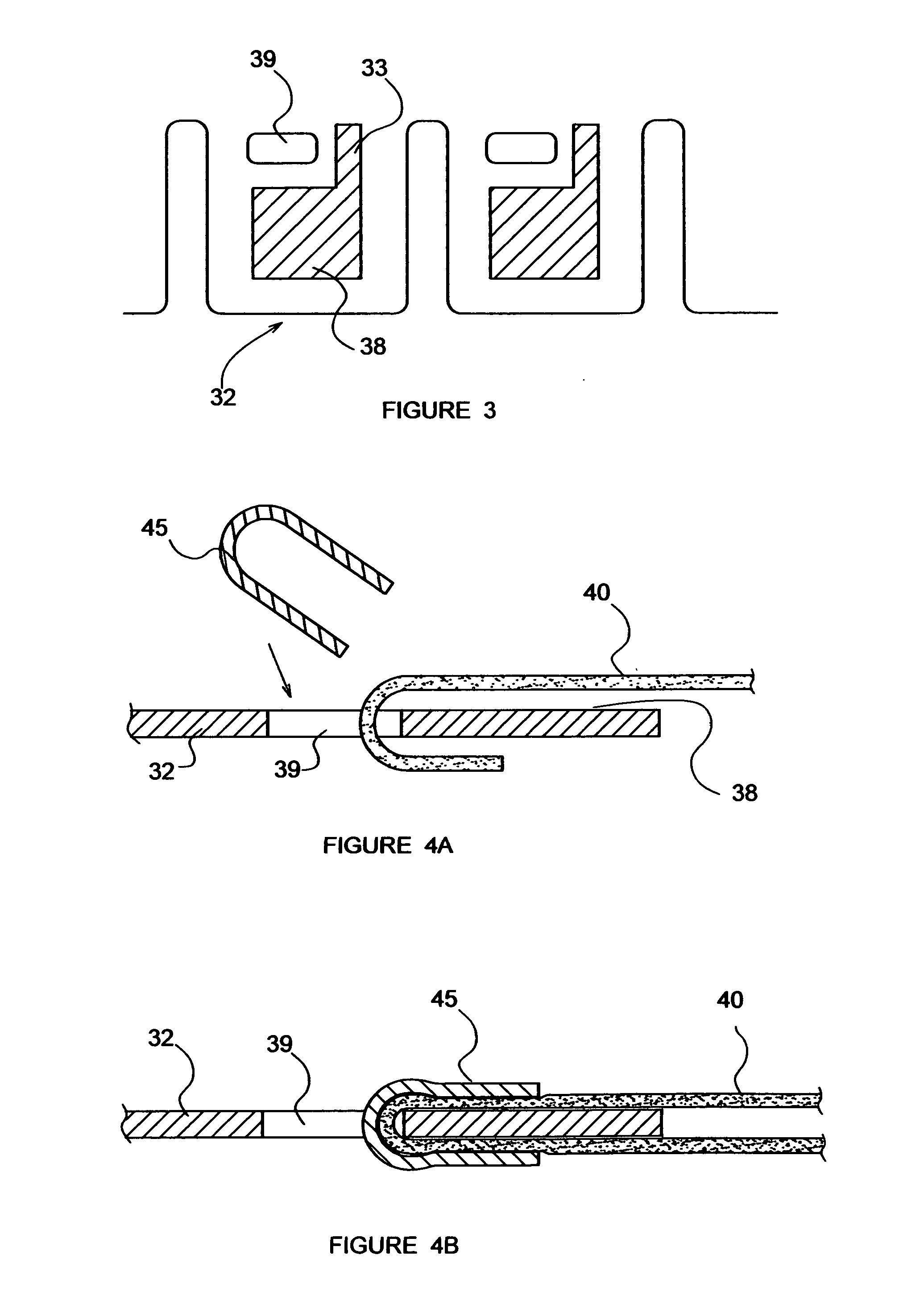Hybrid tactile sensor
a technology of tactile sensor and array, applied in the field of sensors, can solve the problems of unsuitable other organic shapes, and known devices that are unsuitable for covering multi-curvature shapes such as robot fingers, and achieve the effect of well-organized and reducing the risk of failur
- Summary
- Abstract
- Description
- Claims
- Application Information
AI Technical Summary
Benefits of technology
Problems solved by technology
Method used
Image
Examples
second embodiment
DETAILED DESCRIPTION OF THE PREFERRED SECOND EMBODIMENT OF THE INVENTION
[0047] An alternative design of the connecting zone is shown on FIG. 5. A one-sided harness is illustrated here having individual connecting zones 50 spaced apart similarly to that described for the first embodiment but without the plurality of slots cut into the harness. Instead, each connecting zone 50 is attached to the electrode 51 of the sensor array cloth by a fine gauge jumper wire 52, which is first soldered to the soldering pad of the connecting zone 50. Such short single strand jumper wires are not difficult to manage.
[0048] In cases where the conductive cloth cannot be soldered to because it cannot withstand the soldering temperature, the jumper wire soldered to the interconnect harness pad can be inserted through the conductive cloth and bent over backwards to create a mechanical anchor between the harness and the cloth. Conductive epoxy can then be applied to seal it in place. A non-conductive enca...
third embodiment
DETAILED DESCRIPTION OF THE PREFERRED THIRD EMBODIMENT OF THE INVENTION
[0049] A third embodiment of the invention can be advantageously used with the tactile sensor arrays made from fine cloth, which is easily stretched or bent. Another advantage of this embodiment is that it allows attachment to the sensor array with high stretchability. For highly stretchable tactile sensor arrays, one has to take into account that the cloth-based array will stretch in the vicinity of the harness, while the harness itself may not stretch as much. This creates a risk of breaking the electrical contact between electrodes of the array and the conductors of the harness. To avoid that risk, the third embodiment of the invention may include the use of coiled or wavy wires so that they can compensate for the changing distance between the array electrodes and the harness.
[0050] This embodiment may also include the use of a jumper wire 62 attached to a mechanical U-shaped clip 63 as shown on FIG. 6A. Posi...
fourth embodiment
DETAILED DESCRIPTION OF THE PREFERRED FOURTH EMBODIMENT OF THE INVENTION
[0051]FIG. 7 illustrates the hybrid tactile sensor array according to the fourth embodiment of the invention. This embodiment can be used with particular advantage in high volume production of the tactile sensors in banks, each bank containing a plurality of such sensors being worked on at the same time. It is also advantageous for those applications that can benefit from the use of conductive cloth-based tactile sensor array for the physical contact side of the device while the other side is made by extending the intermediate harness connection pad into an electrode strip.
[0052] This embodiment of the hybrid sensor is based upon the use of a conductive cloth 70 in which a series of parallel first electrodes 71 are formed by cutting or another appropriate separation method. In FIG. 7 these electrodes are shown to be horizontally oriented.
[0053] The compliant dielectric non-conductive medium, in this case strip...
PUM
 Login to View More
Login to View More Abstract
Description
Claims
Application Information
 Login to View More
Login to View More - R&D
- Intellectual Property
- Life Sciences
- Materials
- Tech Scout
- Unparalleled Data Quality
- Higher Quality Content
- 60% Fewer Hallucinations
Browse by: Latest US Patents, China's latest patents, Technical Efficacy Thesaurus, Application Domain, Technology Topic, Popular Technical Reports.
© 2025 PatSnap. All rights reserved.Legal|Privacy policy|Modern Slavery Act Transparency Statement|Sitemap|About US| Contact US: help@patsnap.com



